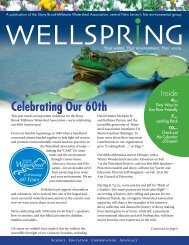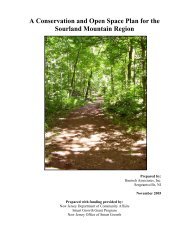History of the Blackwells Mills Dam - The Stony Brook-Millstone ...
History of the Blackwells Mills Dam - The Stony Brook-Millstone ...
History of the Blackwells Mills Dam - The Stony Brook-Millstone ...
You also want an ePaper? Increase the reach of your titles
YUMPU automatically turns print PDFs into web optimized ePapers that Google loves.
Restore Your <strong>Mills</strong>toneenew Your ‘Shedeturn <strong>the</strong> ShadMap <strong>of</strong> <strong>Dam</strong>s on <strong>the</strong><strong>Mills</strong>tone River<strong>The</strong> <strong>Stony</strong> <strong>Brook</strong> <strong>Mills</strong>toneWatershed AssociationBenefits <strong>of</strong> removing <strong>the</strong> <strong>Blackwells</strong><strong>Mills</strong> <strong>Dam</strong><strong>The</strong> two most downstream dams, <strong>the</strong>Calco (yellow) and <strong>the</strong> Island FarmWeir (green) have a notch or fishladder to allow <strong>the</strong> fish to pass <strong>the</strong>dam. <strong>The</strong> Weston Causeway (red) and<strong>the</strong> <strong>Blackwells</strong> <strong>Mills</strong> <strong>Dam</strong> (maroon)completely block migratory fish fromswimming upstream. By removingboth dams, 14 more miles <strong>of</strong> riverwill be opened for migratory fish, aswell as allowing for restoration <strong>of</strong>stream corridors and wetlands.<strong>The</strong> <strong>Stony</strong> <strong>Brook</strong> <strong>Mills</strong>toneWatershed Association is <strong>the</strong> firstenvironmental group in CentralJersey. Founded in 1949, we workto protect and preserve your waterthrough conservation, advocacy,science and education. We protectand restore clean water and naturalhabitats.Through support from AmericanRivers, NOAA, <strong>the</strong> NJDEP, CRI, and<strong>the</strong> Dodge Foundation we plan toremove <strong>the</strong> <strong>Blackwells</strong> <strong>Mills</strong> <strong>Dam</strong>and <strong>the</strong> Weston Causeway <strong>Dam</strong> tohelp reestablish <strong>the</strong> migratory fishpopulation within your <strong>Mills</strong>tone.
<strong>The</strong> Benefits <strong>of</strong>removing <strong>the</strong><strong>Blackwells</strong> <strong>Mills</strong> <strong>Dam</strong>:14 miles <strong>of</strong> river areopened to migratory fish.A public safety hazardis eliminated.An obstacle forrecreational groupsincluding Kayakers andCanoers is removed.Fish populations andopportunities to fish areimproved.<strong>History</strong> <strong>of</strong> <strong>the</strong> <strong>Blackwells</strong> <strong>Mills</strong> <strong>Dam</strong><strong>Blackwells</strong> <strong>Mills</strong>, originally known asSchenk’s Mill, was built in 1747 by PeterSchenck. Ownership had transferred to<strong>the</strong> Blackwell Family by 1828.<strong>Blackwells</strong> <strong>Mills</strong> was a flour and feedmill.<strong>The</strong> <strong>Blackwells</strong> Village grew around <strong>the</strong>Mill and consisted <strong>of</strong> mills, a store andseveral dwellings; it expanded to includeland near <strong>the</strong> Delaware and Raritan Canalwhen <strong>the</strong> canal was built in 1833-1834.In 1870 <strong>Blackwells</strong> <strong>Mills</strong> changed ownership to Augustus Van Zandt. It later switchedhands to John Oakley, finally ending with E.B. Cook. <strong>The</strong> Mill burned in 1905 with arecorded loss <strong>of</strong> $12,000 (around $307,000 in today’s dollars.)<strong>The</strong> original dam was a stone and timber dam,likely built at <strong>the</strong> time <strong>of</strong> <strong>the</strong> Mill’sconstruction. Remains <strong>of</strong> this dam were foundin <strong>the</strong> river and reported by <strong>the</strong> NJ Dept. <strong>of</strong>Conservation and Development in 1921.<strong>The</strong> existing dam, composed <strong>of</strong> cast-in-placeconcrete, was built in 1933.Healthy habitats forstreamside animals andnative plants arerestored.American ShadOne <strong>of</strong> <strong>the</strong> migratory fish that will benefit from <strong>the</strong>removal <strong>of</strong> <strong>the</strong> dam is <strong>the</strong> American Shad. <strong>The</strong>se fish livein salt water but spawn in freshwater. In 1783, JohannSchoepf wrote <strong>of</strong> <strong>the</strong> large number <strong>of</strong> schools <strong>of</strong> shad thatswam up <strong>the</strong> <strong>Mills</strong>tone River until “dams <strong>of</strong> which mayhave been built in recent years keep back <strong>the</strong> shad.” Dueto dams blocking <strong>the</strong>ir migratory paths to ancestralspawning grounds and over fishing, <strong>the</strong> Shad populationhas significantly declined. Efforts are now focused onrestoring <strong>the</strong> Shad to your ‘Shed.











